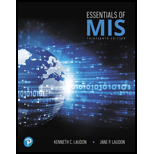
Essentials of MIS (13th Edition)
13th Edition
ISBN: 9780134802756
Author: Kenneth C. Laudon, Jane Laudon
Publisher: PEARSON
expand_more
expand_more
format_list_bulleted
Concept explainers
Question
Chapter 2, Problem 1IQ
Program Plan Intro
Information Systems:
- An
information system denotes a system that offers the necessary material to an organization for achieving the goals. - It monitors details of transactions, provides mandatory information to decision makers, and offers required documents to customers.
- The main components in the information system are people, data, procedures, hardware, and software.
- The main function is to accept as well as process input data, storing the retrieved information and distributing it across firm.
Expert Solution
Explanation of Solution
Details of company:
- The ABC Company is a subsidiary of Tata Group, an IT consulting and business Solution Company.
- It operates in 46 countries worldwide.
- It provides a wide range of IT related products and services.
- It includes business process outsourcing, application development, and consulting, capacity planning and education services.
- The ‘Software Engineer Trainee’ role is been provided to freshers in company.
Explanation of Solution
Commitment to technology:
- The company combines tech expertise and business intelligence to catalyse change as well as deliver results.
- The technology awareness programs inspires future workforce.
- The company supports research activities in technology areas.
- It has technology adoption and transformation solutions including mobile enablement and analytics.
- It ranges from product design and development to release.
Explanation of Solution
Following trend:
- Yes, there was a following trend on company Twitter account on regular basis.
- The details of company, including technological updates are learned from this.
- The company website also provides many details regarding product and services.
- The social media accounts also helped to know more about the company.
Want to see more full solutions like this?
Subscribe now to access step-by-step solutions to millions of textbook problems written by subject matter experts!
Students have asked these similar questions
Dijkstra's Algorithm (part 1). Consider the network shown below, and Dijkstra’s link-state algorithm. Here, we are interested in computing the least cost path from node E (note: the start node here is E) to all other nodes using Dijkstra's algorithm. Using the algorithm statement used in the textbook and its visual representation, complete the "Step 0" row in the table below showing the link state algorithm’s execution by matching the table entries (i), (ii), (iii), and (iv) with their values. Write down your final [correct] answer, as you‘ll need it for the next question.
4. |z + 5 - 5i| = 7
14.
dz,
C: |z❘
C: |z❘ = 0.6
ze² - 2iz
H
Chapter 2 Solutions
Essentials of MIS (13th Edition)
Ch. 2.2 - What Kinds of systems are illustrated in this case...Ch. 2.2 - Prob. 2CQ1Ch. 2.2 - Prob. 3CQ1Ch. 2.2 - Prob. 4CQ1Ch. 2.3 - Prob. 1CQ2Ch. 2.3 - Prob. 2CQ2Ch. 2.3 - Prob. 3CQ2Ch. 2 - Prob. 1IQCh. 2 - Prob. 2IQCh. 2 - Prob. 3IQ
Ch. 2 - Prob. 4IQCh. 2 - Prob. 5IQCh. 2 - Prob. 6IQCh. 2 - Prob. 1RQCh. 2 - Prob. 2RQCh. 2 - Prob. 3RQCh. 2 - Prob. 4RQCh. 2 - Prob. 5DQCh. 2 - Prob. 6DQCh. 2 - Prob. 7DQCh. 2 - Prob. 8HMPCh. 2 - Prob. 9HMPCh. 2 - Prob. 12CTPCh. 2 - Prob. 13CSQCh. 2 - Prob. 14CSQCh. 2 - Prob. 15CSQCh. 2 - Prob. 16MLMCh. 2 - Prob. 17MLM
Knowledge Booster
Learn more about
Need a deep-dive on the concept behind this application? Look no further. Learn more about this topic, computer-science and related others by exploring similar questions and additional content below.Similar questions
arrow_back_ios
SEE MORE QUESTIONS
arrow_forward_ios
Recommended textbooks for you
 Principles of Information Systems (MindTap Course...Computer ScienceISBN:9781285867168Author:Ralph Stair, George ReynoldsPublisher:Cengage Learning
Principles of Information Systems (MindTap Course...Computer ScienceISBN:9781285867168Author:Ralph Stair, George ReynoldsPublisher:Cengage Learning Principles of Information Systems (MindTap Course...Computer ScienceISBN:9781305971776Author:Ralph Stair, George ReynoldsPublisher:Cengage Learning
Principles of Information Systems (MindTap Course...Computer ScienceISBN:9781305971776Author:Ralph Stair, George ReynoldsPublisher:Cengage Learning Information Technology Project ManagementComputer ScienceISBN:9781337101356Author:Kathy SchwalbePublisher:Cengage Learning
Information Technology Project ManagementComputer ScienceISBN:9781337101356Author:Kathy SchwalbePublisher:Cengage Learning Fundamentals of Information SystemsComputer ScienceISBN:9781305082168Author:Ralph Stair, George ReynoldsPublisher:Cengage Learning
Fundamentals of Information SystemsComputer ScienceISBN:9781305082168Author:Ralph Stair, George ReynoldsPublisher:Cengage Learning Fundamentals of Information SystemsComputer ScienceISBN:9781337097536Author:Ralph Stair, George ReynoldsPublisher:Cengage Learning
Fundamentals of Information SystemsComputer ScienceISBN:9781337097536Author:Ralph Stair, George ReynoldsPublisher:Cengage Learning Principles of Information Security (MindTap Cours...Computer ScienceISBN:9781337102063Author:Michael E. Whitman, Herbert J. MattordPublisher:Cengage Learning
Principles of Information Security (MindTap Cours...Computer ScienceISBN:9781337102063Author:Michael E. Whitman, Herbert J. MattordPublisher:Cengage Learning

Principles of Information Systems (MindTap Course...
Computer Science
ISBN:9781285867168
Author:Ralph Stair, George Reynolds
Publisher:Cengage Learning

Principles of Information Systems (MindTap Course...
Computer Science
ISBN:9781305971776
Author:Ralph Stair, George Reynolds
Publisher:Cengage Learning

Information Technology Project Management
Computer Science
ISBN:9781337101356
Author:Kathy Schwalbe
Publisher:Cengage Learning

Fundamentals of Information Systems
Computer Science
ISBN:9781305082168
Author:Ralph Stair, George Reynolds
Publisher:Cengage Learning

Fundamentals of Information Systems
Computer Science
ISBN:9781337097536
Author:Ralph Stair, George Reynolds
Publisher:Cengage Learning

Principles of Information Security (MindTap Cours...
Computer Science
ISBN:9781337102063
Author:Michael E. Whitman, Herbert J. Mattord
Publisher:Cengage Learning